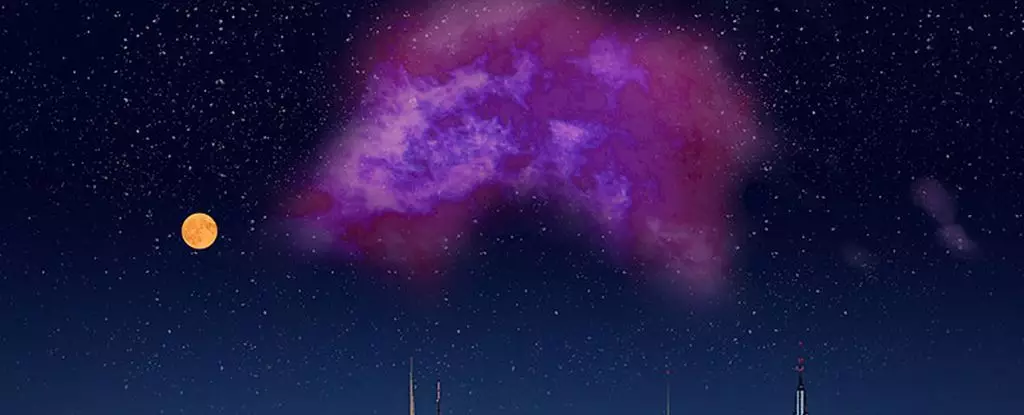In a stunning breakthrough, astronomers have unveiled Eos, a colossal molecular cloud located a mere 300 light-years from Earth, nestled at the edge of the Local Bubble in our galaxy. Named after the Greek goddess of the dawn, Eos represents a monumental leap in our understanding of the universe, particularly regarding the molecular constituents that chart the architecture of star formation. This discovery is significant, not just for its scale but also for its methodology: it’s the first time that scientists have successfully detected molecular hydrogen in interstellar space by harnessing the faint glow of far-ultraviolet light, illuminating areas previously thought obscured.
Dr. Blakesley Burkhart, an astrophysicist affiliated with Rutgers University, summarized this revolutionary finding, stating that “this cloud is literally glowing in the dark.” When one gazes up at the night sky, the vibrant tapestry of stars may seem static, but the cosmos hums with activity that eludes our naked eye. The existence of a vast molecular cloud challenges the traditional perception of interstellar space as a mere void, showing instead that it is alive with material that holds the potential for new stars.
The Dynamics of Interstellar Matter
One intriguing aspect of Eos is that it embodies the essential building blocks from which stars originate. While stars themselves are dazzling celestial bodies, the molecular clouds that seed their formation present a more elusive picture. As Burkhart aptly points out, observing these clouds is challenging due to their faint emissions. The prevailing methods for studying interstellar material often rely heavily on carbon monoxide as a tracer. However, clouds largely devoid of this molecule have remained largely unnoticed, leading to the hypothesis that significant portions of the interstellar medium might still be hidden in plain sight.
By pivoting to a less conventional approach, Burkhart and her research team scrutinized an array of publicly available data collected by South Korea’s STSat-1 ultraviolet space telescope. This innovative methodology yielded remarkable results, as they uncovered Eos, which consists predominantly of molecular hydrogen—approximately 90% of all atoms in the visible universe. This offers profound insight into the fundamental constituents of the cosmos and underscores the potential of dust and gas clouds to play a pivotal role in stellar evolution.
The Size and Composition of Eos
Eos is estimated to have a crescent shape and stretches about 80 to 85 light-years across, containing an extraordinary 2,000 solar masses of hydrogen—an astonishing figure that translates to around 36% of the total mass of the cloud. To provide some perspective, if Eos were visible to the naked eye, it would overshadow the full Moon by a staggering factor of 40. Such dimensions indicate a significant concentration of molecular material, which is currently subjected to photodissociation, a process by which nearby stars facilitate the cloud’s evaporation.
At a dissipation rate of approximately 600 solar masses per million years, Eos is projected to fully dissipate within the next 5.7 million years—an ephemeral blink in the cosmos. This rapid turnover not only highlights the transient nature of astronomical phenomena but also underscores the dynamic processes at play in the interstellar medium.
The Implications for Astrophysics
The implications of discovering Eos extend far beyond just adding a new cloud to our celestial map. This pioneering study offers a clear pathway for future exploration of other invisible molecular clouds that likely exist within the Milky Way and beyond. The techniques employed to uncover Eos—emitting far-ultraviolet fluorescence—could ultimately reshape our foundational knowledge of interstellar matter, granting scientists unprecedented access to realms of the universe that remain shrouded in mystery.
Cosmologist Thavisha Dharmawardena from New York University shares this excitement, suggesting that this work could help unearth hidden molecular clouds, enriching our understanding of star formation throughout the ages. The revelations about Eos will likely yield newfound insights into the epochs of galactic evolution and interstellar dynamics, revealing intricate processes that dictate how gas and dust coalesce into stars and planets.
Charting a New Cosmic Journey
The discovery of Eos is not just a technical feat; it symbolizes humanity’s persistent quest to understand the universe. We live in an age where the cosmos offers both dazzling beauty and tantalizing enigmas. With this transformative finding, researchers are poised to decode the elusive language of the interstellar medium, taking us one step closer to unraveling the grand narrative of our universe’s creation. The journey to understand the depths of space is far from over, but with discoveries like Eos, we are equipped with new tools to navigate the complexities of the cosmos, illuminating the dark and unveiling its secrets.


Leave a Reply